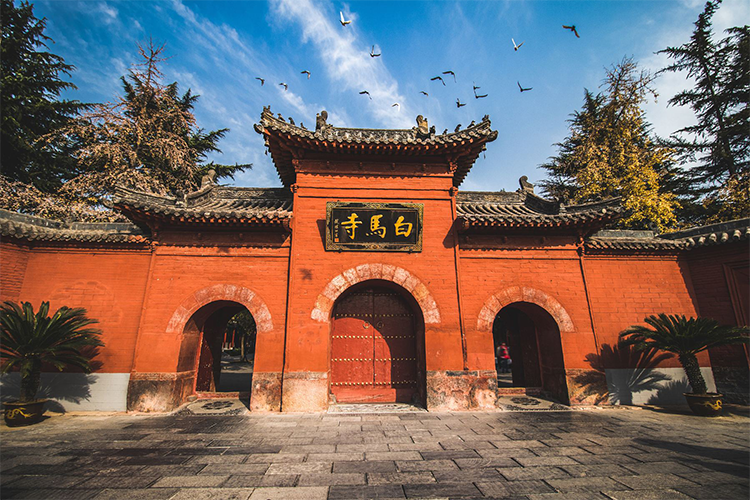White Horse Temple, Luoyang: An Ancient Chinese Temple and China’s First Buddhist Monastery
Morning bells and evening drums echo among ancient pines as a wisp of incense rises—an atmosphere that seems to bridge more than 1,900 years. This is Luoyang’s White Horse Temple, the birthplace of Chinese Buddhism. Behind its weathered red walls lie the earliest memories of Han-transmitted Buddhism and the epic story of Sino-Indian cultural exchange. Run your fingers over the worn carvings on a Tang-period sutra stele and you can almost hear the tinkling of the white horse bells arriving from the Western Regions.
1. The Source: China’s Buddhist Origin Court
In AD 64, Emperor Ming of Han dreamed of a golden figure and dispatched envoys west to seek Buddhist teachings. Four years later, the Indian monks Kasyapa Matanga and Dharmaraksha arrived, bringing scriptures and images on a white horse; an official temple was established to the west of Luoyang. As a zero-kilometer marker for Chinese Buddhism, White Horse Temple predates Shaolin by 424 years. Its status is comparable to Jerusalem for Christianity. Inside, Yuan dynasty dry-lacquer statuary approaches a lost art, and the Main Hall’s “White Horse Bearing Scriptures” relief tells the eastward transmission of Buddhism in 18 vivid scenes.
2. Architectural Epic: A Frozen Dialogue Between East and West
Walking the temple’s central axis is like hearing a thousand-year architectural symphony: a Song-dynasty stone horse at the Shanmen with its mane flying, the Ming Hall of Heavenly Kings with its elegant hipped roof lines, and the Qing-era polychrome painting of the Great Buddha Hall still brilliant. The most striking is the Great Buddha Hall—its lotus column bases echo the style of India’s Sanchi stupa while roof ornaments reveal unmistakably Central Plains craftsmanship. This Sino-Indian fusion reaches its peak in the Reception Hall’s “One Buddha, Two Bodhisattvas” group: the principal Buddha bears a Gandharan, Greco-influenced smile, while the bodhisattvas’ drapery displays the Northern Wei flowing-garment technique.
3. A Time Capsule: Touching the High Tang Through Relics
At 7:00 a.m., when the first sunlight filters through the carved windows of the sutra repository, the gilt characters of the Tang stone carving of the Sutra of Forty-two Chapters seem to come alive. Don’t miss the temple’s three crown jewels: lightweight yet imperishable Yuan dry-lacquer sculptures, a glazed reliquary bottle from the Qiyun Pagoda’s underground chamber that shines Persian-blue, and a Tang-period stone sutra stele in front of the Great Buddha Hall whose Dharani spells preserve uncommon Wu Zhou character variants. East of the bell tower sits a Ming iron bell weighing 3,000 jin (about 1,500 kg), still tied to the legend of the “White Horse Night Cry.”

4. Immersive Experience: Be a One‑Day Luoyang Zen Visitor
Monthly on the lunar 1st and 15th, the morning liturgy is most affecting: at 5:30 a.m. the monastics chant the Shurangama Mantra in the Great Buddha Hall; visitors may stand silently in the corridors to observe. For a deeper taste, buy a vegetarian set meal in the refectory for ¥20—jade tofu prepared from a recipe said to date to the Tang court. On Buddha’s Birthday (lunar April 8), the public is invited to the Bathing the Buddha ceremony: devotees use bamboo ladles to pour water over the prince’s statue, a playful and participatory ritual.
5. Local Insider Tips
– Best time: 6:30–8:00 a.m. to witness monks sweeping leaves and absorbing the scene’s Zen tranquility
– Hidden gem: the west side of the Qiyun Pagoda courtyard has “Qingliang Terrace,” reportedly where Kasyapa Matanga translated scriptures—few visitors find it
– Caution: fortune-telling stalls outside the temple are often scams; genuine masters will never aggressively ask for “merit donations.”

Practical Information
Address: White Horse Temple Town, Luolong District, Luoyang, along National Highway 310
Opening hours: 7:30–19:00 (Apr–Oct) / 8:00–17:30 (Nov–Mar)
Admission: ¥35 (includes the Indian-style Buddha shrine area)
Transport: Metro Line 1 to Yangwan Station, transfer to Bus 56; driving—parking fee ¥10
Etiquette: Do not step on thresholds when entering halls; turn off flash when photographing Buddha images
When sunset gilds the Qiyun Pagoda, sit a while by the broken-Tang-stela pavilion. The fragmentary inscriptions tell a larger story: this is not merely a scenic stop but a sanctified meeting place of civilizations. As Zhao Puchu observed, “To understand White Horse Temple is to read the first three hundred years of Chinese Buddhist history.” Bring reverence—let White Horse Temple be the spiritual beginning of your exploration of Eastern civilization.


